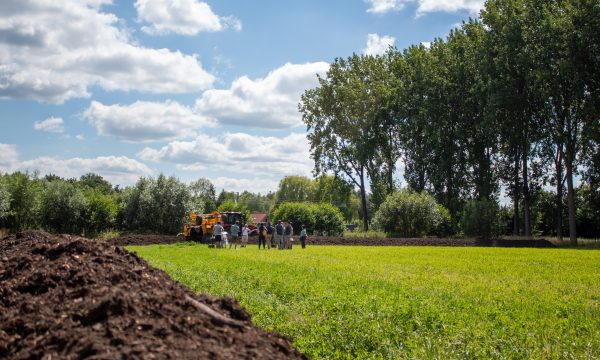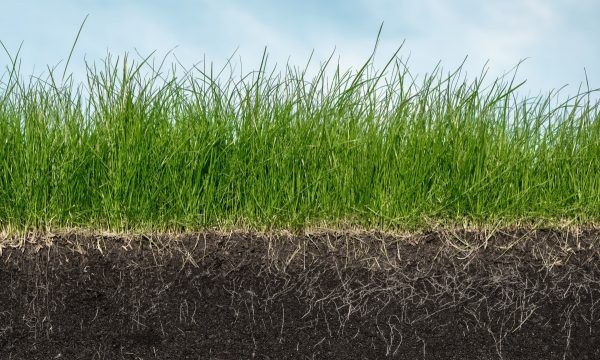Press release First results Flemish carbon monitoring network show importance of correct - deep - sampling.
"In measurements in the topsoil, only 50 to 60% of the total C stock in the soil is measured."
One year after the kick-off of the large-scale Flemish soil carbon monitoring network Cmon, ILVO and INBO together have sampled 8% of the monitoring sites. Despite these limited results, it is already clear that permanent grassland, like forest and nature, contains on average the highest organic carbon stocks. This is in contrast to cropland, which dangles at the bottom of the list. It is also important to note that samples from the topsoil (up to 30 cm deep) contain only 50 to 60% of the carbon stocks measured 1 meter deep. This means that current measurements may give a false picture.
Organic carbon plays a key role in soil quality and climate change. After all, a stable soil with an optimal amount of organic carbon acts as a sponge for water. In addition, it prevents the loss of fertile soil through erosion and is more resistant to compaction when agricultural machinery drives over it. Healthy soil can also help remove CO2 from the air. To do this, the input of organic carbon must be greater than the output. If the decomposition of organic carbon is greater than its supply, then the soil will release CO2 and just contribute to climate change.
Cmon: carbon monitoring network in the fight against global warming
No standardized monitoring network on carbon stocks in Flemish soil was available until July 2021. That is when the Department of the Environment, ILVO and INBO drew up the outline of the Cmon monitoring network, including the selection of measuring points, sampling protocols and analysis methods. The aim is to visualize the evolution of carbon stocks and to adjust and monitor policy accordingly.
Nearly 2600 monitoring plots will be measured over a period of 10 years for not only organic carbon stocks to 1 m depth, but also total nitrogen, acidity and soil texture. ILVO is responsible for carbon surveys on agricultural soils such as cropland and permanent grassland. This fall ILVO will also start sampling and analyses of carbon stocks in private gardens. INBO is responsible for the analyses of natural and forest soils, roadsides and parks. Everything happens under the direction of the Department of the Environment.8% sampling points were sampled
During the past year, 228 of the 2594 sampling points were sampled for the first time (8% of the total). These samplings were spread over the whole of Flanders and over the various types of land use, and were fully analyzed and checked. Especially for fields and grasslands, these first measurements already give a cautious indication:
- The organic carbon stock in the 0-100 cm soil layer is highest in forest, nature, permanent grassland and also roadsides. Parks, recreational areas and croplands have the lowest soil organic carbon stocks.
- Within the same land use class, considerable variation in stocks can be observed. It is expected that as more monitoring sites will be sampled, any differences between classes will crystallize more clearly.
We also find that in the top 30 cm of soil, only 50-60% of the total soil organic C stock is stored up to 1 meter. This means that in measurements that only go to a depth of 30 cm, a lot of organic soil carbon is missed!
Subsoil Database Flanders
All results will go into one database, Databank Ondergrond Vlaanderen, from which the results will be processed and disclosed. The intention is to re-sample the same measuring points in the coming decades. This should allow the evolution of carbon stocks to be visualized and policies to be adapted and monitored accordingly. The network also responds to Europe's compulsory demand to report soil carbon stocks and differences due to changes in land use (the so-called five-yearly LULUCF reporting).
The CMON monitoring network will eventually contain an awful lot of data on carbon and other soil properties, properties of which we now have only a limited idea, such as, e.g., soil bulk density or airiness. This is a direct measure of soil compaction.
Webinar on the inititial research results
On Thursday, June 29 (from 9 to 10:30 a.m.), the first results after 2 years of Cmon will be explained during a webinar. Register for this Dutch-language register until 28/6 at noon.
The annual reports for operating years 2 (July 1-July 22 to June 30, 2023) and 1 (July 21-June 22) are online at the website of the Department of the Environment.
The Environment Department coordinates and funds this Cmon research. The practical implementation of the project lies with the Cmon consortium, consisting of the Environment Department, the Institute for Agricultural and Food Research (ILVO) and the Institute for Nature and Forest Research (INBO).


